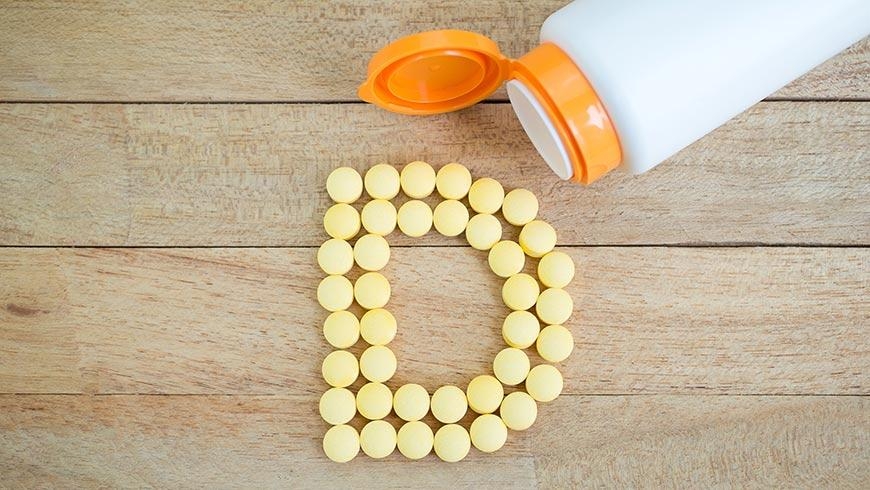
Vitamin D
The most important function of vitamin D is to increase the absorption of calcium and phosphorus in the intestinal system, and its key effect is to strengthen the skeletal system of adolescents and adults. Vitamin D also increases the absorption of iron, zinc and magnesium. In addition to these effects, vitamin D is likely to have several other health effects, as it regulates the activity of hundreds of genes in the body.
When your skin is exposed to sunlight, it manufactures a prohormone of the active form vitamin D. However, in the dark months of the year, in particular, the vitamin D content of most diets is not enough, and vitamin D supplementation is required. Because of this, the sufficient supply of vitamin D should be ensured at the beginning of the dark months. This can be done by testing the level of 25-hydroxy-vitamin D, or calcifediol, in blood (S-D-25). The test is an indicator of the supply of vitamin D and the content of vitamin D in the body.
Regularly taken tests should be analysed by the same laboratory as different laboratories use different methods. The sample can be taken at any Mehiläinen outpatient clinic. All analyses are performed at the Mehiläinen central laboratory in Töölö, Helsinki.
What are the symptoms of vitamin D deficiency?
Vitamin D deficiency may increase the risk of osteoporosis and bone fractures. Studies also show that vitamin D deficiency is sometimes associated with increased susceptibility to infections, i.e. immune system disorders, depression, diabetes, cancer, cardiovascular diseases, imbalance, muscle weakness, autoimmune diseases and degenerative nerve diseases. A direct link has not been proven to exist in all these cases, however.
Vitamin D deficiency is common among the adult population of Finland
Studies conducted in Finland indicate that vitamin D deficiency is slightly more common among women than men, and that only approximately one in six people in Finland have an ideal level of vitamin D in their blood with regard to the health of their skeletal systems (more than 75–80 nmol/l). The vitamin D level of both men and women is linked to age and physical activity. Obese people have lower vitamin D levels than people with a normal weight. Obese women of working age who are not physically active and do not use vitamin D supplements are at the greatest risk of vitamin D deficiency.
Vitamin D deficiency and age
The risk of vitamin D deficiency is particularly high among the elderly, as the skin’s ability to produce vitamin D becomes weaker with age, exercise is less frequent and the long-sleeved clothes worn in the summer may block sunlight from the skin. An unbalanced diet may also increase the risk of vitamin deficiency among the elderly.
Vitamin D doses – Recommendations
In addition to vitamin D contained in the diet, the year-round recommendations for vitamin D intake are:
• 10 µg/day for children aged 2 weeks–2 years
• 7.5 µg/day for children and young people aged 2–17 years
• 10 µg/day whenever necessary for adults aged 18–60 years
• 10 µg/day whenever necessary for adults aged 61–74 years
• --> 75 years 20 µg/day**
• Pregnant and breastfeeding women 10 µg/day
* If dairy products, fats and/or fish that contain vitamin D are not used during the darkest months of the year (October–March).
** A smaller dose of vitamin D supplements (10 µg/day) may be enough if a lot of dairy products fats and/or fish that contain lots of vitamin D are also used.
The safe maximum daily intake of vitamin D is most likely approximately 100 µg/day. Units used: microgram (µg) and international units (IU); 10 µg = 400 IU
Vitamin D content of foods
Oily fish is a good source of vitamin D. Other good sources of vitamin D include dairy products and spreads with added vitamin D.
Content of vitamin D in a portion of 100 g:
• Zander 24.8 µg
• European whitefish 22.1 µg
• Light spreads and margarine 20.0 µg
• Herring 17.0 µg
• Chanterelles 12.8 µg
The skin can produce up to 10,000 IU (250 µg) of vitamin D in 20 minutes of exposure to sunlight. Being exposed to sunlight regularly over two weeks can more than double the content of calcifediol in serum. The content will decline in a matter of weeks, however, and a single holiday in the sun is not enough to store vitamin D for the entire winter.
Overdose on vitamin D
Even if dairy products that contain added vitamin D are used widely, the intake of vitamin D cannot exceed the limit considered to be safe. Vitamin D produced by the skin or retrieved from the diet cannot cause vitamin D toxicity, but the active form of vitamin D (calcitriol) can lead to an overdose in kidney patients.
Symptoms of vitamin D toxicity may occur if the S-D-25 value is more than 300 nmol/l, in which case the blood’s calcium level is also high. The symptoms include loss of appetite, weight loss, general weakness, disorientation, vomiting and dehydration.
How to request these tests?
The vitamin D test can be performed in our laboratories without a referral. You can book a time at any Mehiläinen location via the online booking service. You do not have to remain without food or liquids prior to the sampling, and the test does not need to be performed at a certain time of the day.
Price of a vitamin D test
The price list for laboratory tests shows the prices of the most common samples and tests without Kela reimbursement.
Where can the results be viewed?
The results of laboratory tests are stored in the OmaMehiläinen service, where you can browse them whenever you like. Download the OmaMehiläinen application to access the service on your phone. The browser version of OmaMehiläinen can be accessed here.



